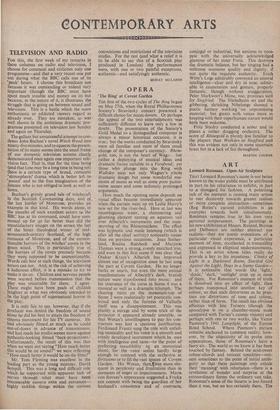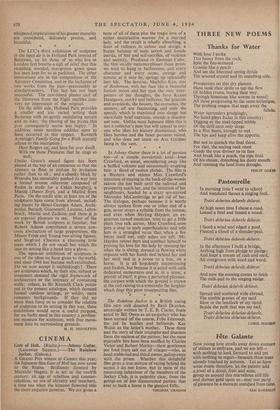ART
THAT Leonard Rosoman's name is not better known to the wider public must be attributed in part to his reluctance to exhibit, in part to a disregard for fashion. A polarising itch of the moment is causing many artists to veer decisively towards greater realism or more complete abstraction—sometimes (Reg Butler's current exhibition is an example) towards both simultaneously. Rosoman remains true to his own very personal temperament. The paintings in his new exhibition at Messrs. Roland, Browse and Delbanco are neither abstract nor realistic—they are poetic evocations of a particular visual experience, a particular moment of time, recollected in tranquillity and expressed in elliptical understatements. This is an artist whose titles really do provide a key to his intentions: Chinks of Light in a Darkened Room, Startled Girl Against the Light, Dogs in a Sunny Garden— it is noticeable that words like 'light,' shade,"dark," sunlight' crop up in most of them. For Rosoman's moment of truth is dissolved into an effect of light, then perhaps transposed into another key of colour, so that such distortions as he prac- tises are distortions of tone and colour, rather than of form. The result has obvious affinities with late Turners (though the apocalypse is on a chamber-music scale compared with Turner's cosmic visions) and perhaps with one or two works, like Victor Pasmore's 1941 Lamplight, of the Euston Road School. Where Pasmore's picture remains anchored to common reality, how- ever, by the objectivity of its probe into appearances, those of Rosoman's have a faery air. The world as we know it has been touched by fantasy. Behind the acid-sweet colour-chords and reticent tonalities—reti- cent sometimes to the point of initial ambi- guity so that these paintings only exhale their 'meaning' with reluctance—there is a revelation of wonder and surprise at the extraordinary forms the ordinary can take. Rosoman's sense of the bizarre is less forced than it was, but no less certainly there. The whispered implications of his greater maturity are considered, delicately precise, and beautiful.
The LCC's third exhibition of sculpture in the open air is in Holland Park instead of Battersea, so let those of us who live in London first breathe a sigh of relief that this rambling, wooded, overgrown green space has been kept for us as parkland. The other innovations are in the composition of the Advisory Committee, and in the inclusion of two works from the past—presumably as standard-setters. This last has not been successful. The raw-tinted plaster cast of the Dionysus from the Elgin marbles con- veys no impression of the original.
On the debit side, Holland Park provides a smaller and less varied setting than Battersea with its gently undulating terrain and its lake; the placing of the pieces this year consequently seems less happy. In addition, some needless oddities seem to have occurred in this respect. Kenneth Armitage's Family Going for a Walk scarcely relates to the inscription : Here Rogers sat, and here for ever dwell With me those Pleasures that he sings so well; Emilio Greco's seated figure has been placed at the top of an eminence so that she appears to float in mid-air by levitation rather than to sit ; and a chunky block by Wotruba has unsuitably pushed its way into a formal avenue otherwise composed of Rodin (a study for a Calais burgher), a Manzi (Dance Step), and a Maillol from Paris. On the credit side, at least ten of the sculptures have come from abroad, includ- ing pieces by Henri-Georges Adam, Archi- penko, Barlach, Giacometti, Laurens, Lehm- bruck, Marini and Zadkine and these it is an especial pleasure to see. Most of the work by British sculptors is familiar, but Robert Adams contributes a severe con- crete abstraction of large proportions, the Misses Frink and Young two sitting figures, and Siegfried Charoux a charming little piece which I do not recall but which fits into its setting like a hand into a glove.
The open-air exhibition of sculpture is one of the ideas we have given to the world, and since 1948 has become well-established. Do we now accept it unthinkingly? There are sculptures which, by their size, subject or treatment demand the rigid framework of architecture or the intimacy of containing walls; others, as Sir Kenneth Clark points out in the present catalogue, which demand formal outdoor settings, or wilder, more romantic backgrounds. If they did no more than force us to consider the relation of sculpture to its setting in this way, these exhibitions would serve a useful purpose, for we badly need in this country a perMan- ent museum for sculpture, with free move- ment into its surrounding grounds.



































 Previous page
Previous page